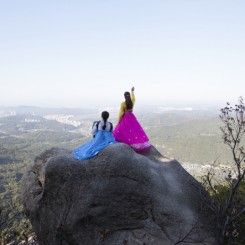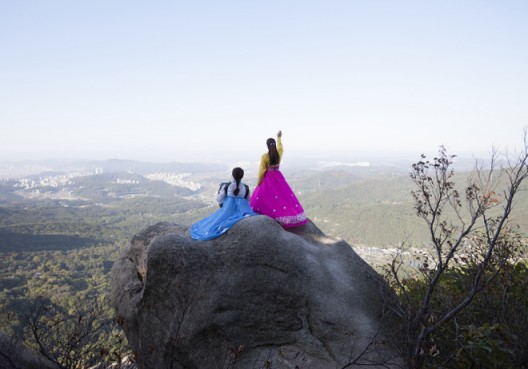Review of the 2016 Taipei Biennial “Gestures and Archives of the Present, Genealogies of the Future”
I.
As the by-product of international expositions, the biennial/triennial/multi-ennial model not only shapes the development of modern and contemporary art history, it is also intimately tied to the course of modernity: through visual presentation to the construction of discourse(s), it writes its own history. As that history is being written, we also know that many invisible others are excluded, constituting one of the key reasons driving the transnational launch of decolonization projects since the rise of post-colonialism. Against this backdrop, archives—inseparable from history and identification—play a crucial role. Since the post-war period, the excavation, interpretation, and classification of archives has thus precipitated waves of “transitional justice” movements everywhere. As the extensive self-evaluation—both active and passive—that governments are launching from within systems (of the body-politic), transitional justice, or, simply put, overdue justice, aims to investigate perpetrations resulting from the upholding of past regimes in the excavation of historical truths. Due to its international orientation and complex history, not only is Taiwan in the process of decolonization, it is also one of the best sites for examining the relationship between postcolonial theory and international contexts. In a place where almost all cultural activity is dependent upon official subsidies and where public museums are dominated by strong cultural leadership, critical reflections on official cultural systems have become an urgent topic.
Therefore, this year’s Taipei Biennale, entitled “Gestures and Archives of the Present, Genealogies of the Future”, gestures at a long-anticipated and forceful attack on the archival canon. The curator seems to stand by the framework of modernist aesthetics, however; there seems to be no need to mention the emblem of the “fortress of art” (yishu baolei) inherent in its site of enactment (for military metaphors that refer to the museum as fortress, please see Boris Groys’ The Politics of Equal Aesthetic Rights, or my own essay “The Ghost of History—On the Usage of Archives in Contemporary Curatorial Morphology”). Furthermore, as I have prefaced, if one were to have any understanding of past Taipei Biennials and the Taiwan Pavilion in Venice, both of which have been overseen by Taipei Fine Arts Museum, one will easily find that a complex political background and awareness of identification both directly shape the varying presentations of these exhibitions. The Taipei Biennial also reflects TFAM’s bureaucratic authority, vacillating between national subjectivity and the capital’s cultural leadership. This background needs first and foremost to be taken into account.

劳伦斯·阿布·汉丹,《橡皮涂层钢》,高画质录像,彩色、有声,片长19分,2016
Lawrence Abu Hamdan, “Rubber Coated Steel”, HD video, color, sound,19 min, 2016

劳伦斯·阿布·汉丹,《橡皮涂层钢》,高画质录像,彩色、有声,片长19分,2016
Lawrence Abu Hamdan, “Rubber Coated Steel”, HD video, color, sound,19 min, 2016
II.
Yet, what should a biennial look like? Nobody can answer this, because a biennale should not look like anything to begin with. In my view, the Taipei Biennial has always anxiously sought the so-called “international”, or vice versa; the organizers seem to think it appropriate to draw on the latest trends from international biennials in order to catch up with mainstream discourses in Western countries. As a result, “Animism” in 2012, “Anthropocene and Acceleration” in 2014, and “Archive Performing” in 2016 all attempted to introduce or respond to topics deemed important at the present moment. From this point of view, TFAM has played the role of the museum well as an educational hub that promotes connections with the local. In 2016, the curator Corinne Diserens brought many important artists from Europe, including ideological trends and movements since the emergence of avant-garde art, such as the Situationist International and the Communist International, encompassing the historical span of a century. Perhaps due to actual working conditions and a lack of familiarity with the culture of Taiwan and nearby East Asian countries, she did not touch too much upon “incorrect” events, if at all; most of her samples focus instead on constructing an imagination of Taiwan through a network of connections centered on authority. From an etymological standpoint, granted its numerous definitions, and the extensive research required for its Chinese translation, “archive” more or less means “the documentation of specific events” and is tied to modes of administrative control for which the keywords are “public records” and “beginning”. Thus, so-called incorrect events often satirically alter the original meaning of the archive (the real appearance of its “publicness” and “beginning”): the public would be covered up, the documentation tampered with, and the origin either effaced or fictionalized—which is why we need transitional justice. As such, the archive not only reflects but on some level also determines the specific image of history. More importantly, due to the fact that the archive often affects regional politics, it is limited to the region. Looking broadly at this biennial though documents and archives, history seems to have vanished into thin air amid the imaginary connections forged between the international and the local. Hence the foreign curator, deeply restricted by language barriers, is unfortunate—but it’s not her fault. Though on several occasions Diserens has admitted her lack of knowledge about Taiwan, she firmly believes that the works she chose, which unfold around current international situations, and artists’ relationships with modernism (she thinks we have never escaped from modernity), as well as the accumulated legacies refracted by modernism, could all constitute the universal foundation for current discourse.
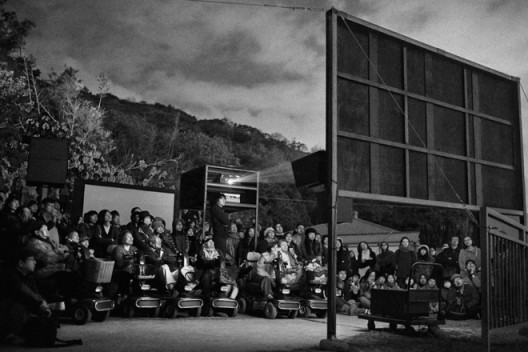
陈界仁,《风入松》,单频道录像,蓝光光盘、黑白、有声,片长23分17秒,2015
Chen Chieh-jen, “Wind Songs”, single channel video installation, blue-ray disc, b/w, sound in selected portions, 23 min 17 sec, 2015
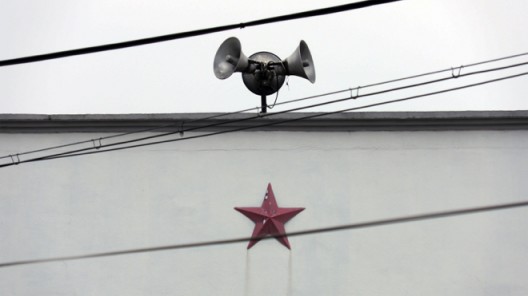
洪子健,《尼采转世为一位中国女性与他们共享的生命》,多媒体表演艺术(影像撷图),2016
James T. Hong, “Nietzsche Reincarnated as a Chinese Woman and Their Shared Lives”, multimedia, still image, 2016
If the Taipei Biennial orients itself far beyond Taiwan itself and focuses on east Asia and southeast Asia, then perhaps the majority of the works in the exhibition that follow the trajectory of Western art (paying homage to grand masters) are sufficient for us to rearrange the genealogy of archives, documents, and relevant ideologies in the course of modern and contemporary art history (though this still constitutes modernism). Yet the more challenging question remains: how to understand Asia’s post-colonial condition? On the one hand, the curator’s nationality does not explain much. But if we were to show the construction of the archive and the organization of genealogies, the barrier between language, culture, and regions should be brought to light. On the other hand, in terms of her curatorial gesture, it is clear that Diserens prefers non-topical exhibitions (in fact, topical modes of exhibiting have been making a come-back in international biennials of recent years—this is another topic worth discussing). Instead of providing a clear framework and definition, she turned to performance, film, and interactive symposiums to mold the field of vision. She has also incorporated locally initiated research proposals—such as Tainan China Town, a research plan led by Yi-Hsin Lai and others, Soundscape Taiwan, a project developed for many years by Hueihua Cheng and Lo Jeph, as well as field research conducted by Gong Jow-Jiun on folklore in photography—as a way to breach archives outside her field of vision. Though she does not resist the bureaucratic gags put in place by collaborating with institutions, believing that almost nothing in contemporary life could escape this category, perhaps it would be better to think about the possibilities found within the system. But in terms of the exhibition itself, it surprisingly fails to touch upon controversial archives about the national and the local, or abandon the perspective of a politics of aesthetics. Instead, she focuses on “artistic” gestures (in her words), anti-modern projects that question, deconstruct, and divert the “paradigm”. But in this fashion, even the fiercely powerful works of Chen Chieh-Jen have somehow lost their force.
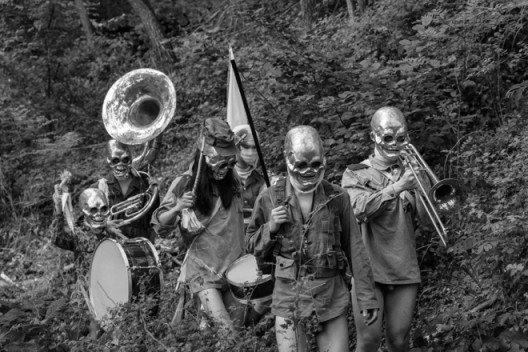
朴赞景,《公民森林》,三频道录像,黑白、有声,片长27分钟,2016(Art Sonje Center与2016台北双年展提供)
Park Chan-Kyong, “Citizen’s Forest”, three-channel video, b+w, directional sound, 27 min, 2016 (Courtesy of Art Sonje Center and the Taipei Biennial 2016)
III.
Although due to various limitations, the curator was not able to pay too much attention to works that deal with Taiwan’s cultural-historical circumstance, Diserens did draw a constructive imaginary route for the “archive”—this is worth further discussion. This constructiveness can be seen in the subheading given by Diserens: “Performing the architecture”, which attempts to create more room for imagination within the symbolic structure of culture and power in order to transfer two-dimensional (if not crumbling) file cabinets and documents piled in the deployment of time to the three-dimensional structure of everyday living space. In If There’s Been A Way to Build It, There’ll Be A Way to Destroy It, the renowned literary critic Ian Hunt makes a metaphorical bridge between archive and architecture, using London’s urban renewal as an example (and the accompanying evaporation of cultural landscapes) in order to connect with the artist Paul Buck’s autobiographical publications in the search for spatial allegories that we depend so much upon in the process of “self-archiving”. A Public Intimacy (A Life Through Scrapbook), Paul Buck’s classic work, tries to present his autobiography and life retrospective to readers through the method of montage—an unedited and uncompleted creative plan—so that the reader could see how “process” reveals the author’s personal life. All this is as important as the identity of the author/artist, for whom the plans constitute the “result”—in terms of the particularities of the autobiographical form (the “authentic”). Just like the process of gentrification in urban metropolises, “beautiful results” always conceal and destroy precious processes (namely, the traces of history). And if the construction of archives also requires “correctness”, just as autobiographical forms habitually do (for this reason, archives could not be separated from photographic techniques for a long time), then all the landscapes we find in daily life can only be dazzling appearances—all beautiful houses and public construction.

安洁拉.费瑞拉,《倾向遗忘》,多媒体影像装置,雕塑:密集板,松木条、铁,液晶显示器;460×565×415公分,七幅照片:喷墨输出;70×100公分,录像:16:9,彩色,有声;15分钟循环播放,片长19分15秒,2015
Ângela Ferreira, “A Tendency to Forget”, multi-media installation, sculpture (MDF, pine beams, iron), LCD; 460×565×415cm, 7 photos: inkjet print; 70×100cm, video:16:9, color, sound, 19 min 15 sec loop, 2015

安洁拉.费瑞拉,《倾向遗忘》,多媒体影像装置,雕塑:密集板,松木条、铁,液晶显示器;460×565×415公分,七幅照片:喷墨输出;70×100公分,录像:16:9,彩色,有声;15分钟循环播放,片长19分15秒,2015
Ângela Ferreira, “A Tendency to Forget”, multi-media installation, sculpture (MDF, pine beams, iron), LCD; 460×565×415cm, 7 photos: inkjet print; 70×100cm, video:16:9, color, sound, 19 min 15 sec loop, 2015
In the debate over construction and demolition, what is sacrificed is argued for in the name of people’s memories which, just as in the process in which national archives are established: “to construct (archives), is to make people forget.” Ian proceeds to quote “memory palaces”, as a way to explore the relationship between systems of memory and architecture. Memory Palaces are architectural metaphors denoting the visualization of memory systems, in which all the memory (archive) placed in each room could be easily found and played back during each recollection of memory. However, the above-all premise is that there be a place dedicated to “being located”. In terms of etymology, the word “locate” originates from “locus”, which connotes trajectory, site, and control; having definitions in mathematical trajectory and segmentation, trajectory is also profoundly linked to topology, later used in the discussion of spatial positioning on a cultural and mental level. Interestingly, just like all the architecture and streets we are accustomed to seeing every day, it is often difficult to be aware of this constant process of “being located”: as every space for “being located” is continuously destroyed, we can only recognize rapidly changing “results”. This is the way in which modernity makes us forget, in making us accept the reality of life that it institutes (see Paul Connerton’s How Modernity Forgets). The reason Peter Friedl, one of the artists in the exhibition, restages notorious or ill-fated architectural works in the history of modernity and names it “Rehousing” is to extract them as micro-archives (at the same time as spectacles) from the original threads in which they were entangled so that they can be understood in an unfamiliar context. Furthermore, Angela Ferreira’s work “A Tendency to Forget” could also be read in this discursive rubric. In presenting classic examples from the archival documents of the famed anthropology couple Jorge and Margot Dias, the micro-laboratory created by the artwork attempts to overturn the colonialist angle hidden within, revealing the complex relations between knowledge and power within anthropology in the construction of modernity. These architectural spaces herein are no longer sufficient in enveloping people and thus making them hard to detect; conversely, in ensuring a line of vision that allows one to see comprehensively and at close range (try to imagine the posture of viewers who bend down and crane their neck), it overturns paradigms of modernity.
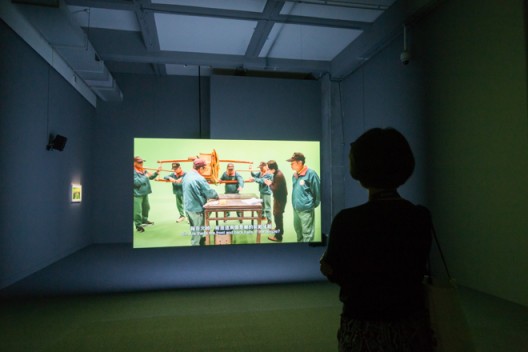
许家维,《神灵的书写》,双频道录像装置,片长9分45秒,制片人:Le Fresnoy,联合制片人:尊彩艺术中心”,2016
Chia-Wei Hsu, “Spirit-Writing”, two-channel video installation, 9 min 45 sec, Produced by Le Fresnoy, Co-producer: Liang Gallery, 2016
IV.
If the above two works highlighted the fate of archival construction and modernist architecture in mental space, “Collectivism”, the large-scale installation placed in the outdoor atrium on the first floor (by the artist duo Eric Chen and Rain Wu) reshaped the landscape of contemporary life in the embodied organic imagination. In contrasting the unbridled growth of botanical gardens with shields that signify the governing of nations, the work strengthened the satirical metaphor between “bodily defence and nurture”, responding at the same time to the previously mentioned viewpoint—“architecture is made for forgetting”. Therefore, the curator created numerous “temporary rooms” in the museum, placing these disruptive rooms within bureaucratic hierarchies (of architecture), hoping to provide audiences with the opportunity for radical thought, more so expecting to “unravel the structure of power”. Perhaps idealized, to me Corinne has overestimated Taiwanese audiences’ imagination of the world, mostly coming from historical and cultural conditions of different regions as well as the complex development of modern art history, forcing the viewer to become lost in a torrent of information. Paradoxically, this kind of imaginary flow is precisely what is needed at present so as to dismantle the unshakeable archives that result from the construction of modernity. Though tiny flaws do not negate the merit of the whole, the curator has deliberate created an empty exhibition narrative, complemented with almost all-encompassing archival samples, as though this biennial was the “search results” of having typed in “document/archive/history” in the browser. Perhaps it failed to show hidden genealogical cartographies (that is, if genealogy is indeed what the exhibition had in mind), and risks floating superficially on the surface. Lastly, I would like to ask: what about archives of the future? How is it to be performed? Looking around at contemporary informational life, highly developed algorithms and their product, big data, largely determine how we document the present as well as ways of looking at the world. The most conspicuous examples aside, businesses and entrepreneurs are able to figure out most people’s needs through big data analysis, insidiously inserting ads along every commercial route, thus generating “additional” needs, ultimately depositing the populace in a preprogrammed future. However, it is a pity that discussion of this new domain remains curiously missing from this year’s Taipei Biennial, which, aside from immersing visitors in a strong sense of nostalgia, reduced its power in shaking the foundations of aesthetic paradigms.
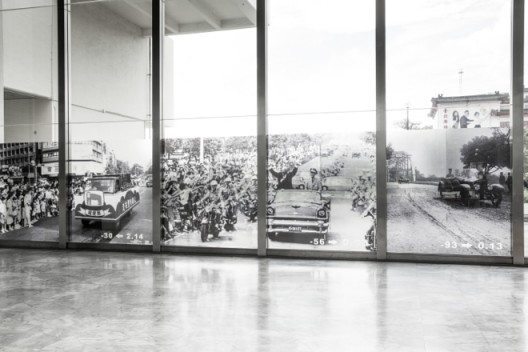
黄立慧,《快乐天堂》,大图输出:1190 ×250公分,计算机割字,硅胶,隔热纸,音乐:快乐天堂,30位观众现场参与,尺寸视场地而定,2016(图片来源:联合报系。台北市立动物园于1986/9/14举行大搬家游行,在警车的前导下,六十五只动物分乘廿辆专车,从圆山动物园出发,驶往牠们的新家木栅动物园,吸引了廿万以上热情、好奇的民众夹道围观)
Li-Hui Huang, “Happy Paradise”, large format transparency: 1190 ×250 cm,vinyl letters, silicone, mylar window tint film, soundtrack: Happy Paradise, 30 audience participation on site, dimensions variable, 2016
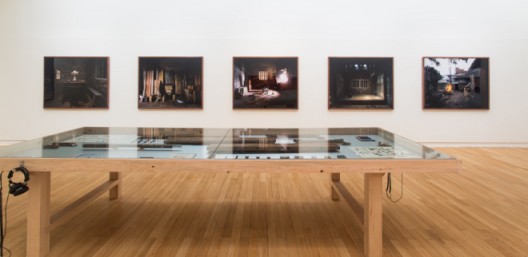
叶伟立 & 叶世强,《铁锤,叶世强水湳洞旧居》,雷射感光相纸、水晶裱,木框,125 X 155 X 5公分,2016
Yeh Wei-Li & Yeh Shih-Chiang, “Hammer, YSC Shuinandong Residence”, lightjet print, acrylic face mount, reclaimed wood frame, 124x154x5 cm, 2016
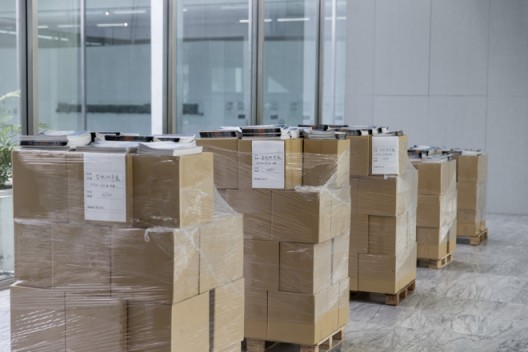
尚路克·慕连,《「三8」烟斗》,cibachrome相纸、diasec装裱,47 × 36公分,1999–2000
Jean-Luc Moulene, “ ‘The three 8s’ pipe.”, cibachrome print, diasec mounted, 47 × 36 cm, 1999–2000
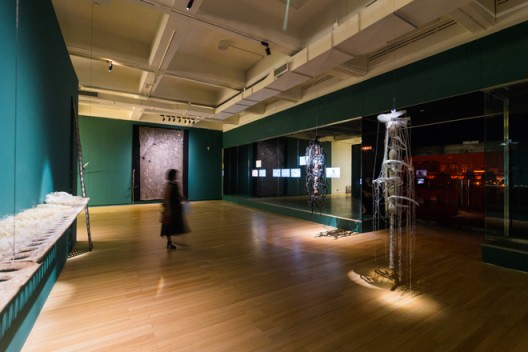
林珉旭,《假设的承诺_洞穴—手的重量》,单频道高画质录像,彩色、有声,片长13分50秒,2010(Platform L典藏)
Minouk Lim, “The Promise of If_Cave-The Weight of Hands”, HD single-channel video, color, sound, 13 min 50 sec, 2010 (Collection of Platform L)

纳思琳.塔巴塔拜 & 巴贝克.艾菲斯比,《吸入》,文字纸本、铝框、3D动画,2016
Nasrin Tabatabai & Babak Afrassiabi, “Inhale”, texts on paper, aluminum frames, 3D animations dimensions variable, 2016

曾伯豪 & 鬼讲堂,《鬼讲堂》,现场表演,90分钟,2015(全球首演,2016年11月25、26日,纪州庵文学森林)
Po-Hao Tseng & Lecture of Ghost, “Lecture of Ghost”, Performance, 90 min, 2015 (World primiere at Kishu An Forest of Literature on 25th and 26th November 2016)
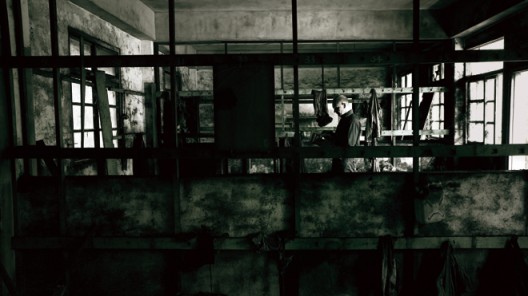
高俊宏,《博爱》,单频道录像、重返现场艺术行动,片长50分钟,2016
Kao Jun-Honn, “Bo-Ai”, single-channel video, art activism/ returning to the site, 50 min, 2016
